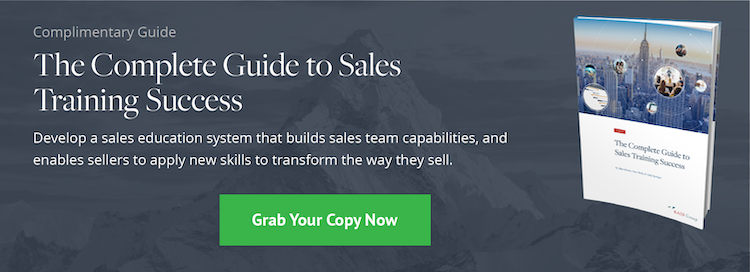There's one question I wish I got asked more when working with leaders looking to invest in B2B sales training. That question is, "What will it really take to get the best results?"
If you're a seller, you can probably relate to the experience of a well-meaning trainer giving examples from an industry that had nothing to do with yours. Or maybe they didn't have a credible track record to back up their claims. And when the training was over, it was back to business as usual the next morning.
No learning. No change in behavior. No results.
Ask the average trainer what business they are in, and they will likely answer "I am in the training business." When I'm asked the same question, however, I answer "I'm in the sales performance improvement business."
This isn't simply semantics. The way I see it, a sales trainer's job is to deliver results for their clients. In our case, the results come in the form of measurable, observable improvements within the salesforce.
These changes don't make themselves happen. We've found that when these 5 factors are in place, our clients get the most out of their B2B sales training programs.
Factors of Successful B2B Sales Training
1. Tailor Training to Your Industry
One of the biggest destroyers of credibility for any trainer or program is using "one size fits all" examples and case studies. If your business is a management consulting firm, your sales training program shouldn't include a case study on pharmaceutical sales.
80% of the time, when I'm told that "our guys are skeptical when it comes to training," it's due to the fact that they've been presented with materials and content that was not adapted to their industry, context, or specific challenges. No relevance. No credibility.
Making sure that your training program uses examples, stories, case studies, exercises, and role plays that are tailored to your industry is an important first step in ensuring that B2B sales training actually delivers results.
2. Provide Job Aids and Tools
What happens after sellers leave the training room and get back into the real world? All too often, implementation is left to chance.
Along with management support and expectations that sellers will apply new skills and behaviors, the training should provide practical job aids and tools such as planners, checklists, frameworks, and conversation guides. The right tool or job aid makes selling much easier, and training much more likely to be applied.
3. Assess Learning Needs Ahead of Time
Unless you assess your sellers' learning needs and areas for improvement ahead of time, how will you know whether they've improved after the training is over?
If you figure out where your salesforce's key areas for improvement lie, you'll know what areas to emphasize and improve during the program. You'll know how to tailor the content to each individual's needs.
A pre-training skills assessment is also the foundation for the reinforcement and coaching stages that should take place after the sales training is over.
4. Reinforce Training
When I'm speaking with a decision maker, they'll sometimes tell me that "sales training just doesn't work." They will then go on to tell me a story about how they had a trainer come in in the past who did a fantastic job and everyone was really happy. And yet, nothing happened in terms of results.
When I probe for further information, and ask them what they did after the training, I'm often met with blank stares and silence.
How would you feel if a driving school offered in-classroom training, but no road practice? If your kid's swimming teacher took all the kids to a room, showed them a video, and then told them to simply "dive in" tomorrow morning?
Recent advances in psychology and science have taught us that habits are the cornerstone of real, lasting change. When habits change, behavior changes. When behavior changes, results change.
For any kind of training (whether B2B sales training or otherwise) to truly create long-term change, a solid post-training reinforcement program needs to be put in place. This will ensure that participants get the encouragement, feedback, and accountability required to change their habits, and thereby change their (and their company's) results.
5. Coach Sellers
Over the years, my own teaching style has evolved. Less content, more interaction. Less teaching, more coaching. Often, I'm told that the most valuable moments in a training program are the times when we've gone off the planned path, and we're doing real-time group coaching on relevant issues and challenges.
Once sellers achieve a certain level of understanding, lecturing isn't helpful. Sellers often know what to do, but they're struggling with how. Even sellers that have a good foundation in the basics are searching for new ideas and the right strategies to tackle their sales challenges.
Coaching, whether in-classroom or after the training is over, is a great way to maximize B2B sales training results.
Time and time again, we've seen that companies who invest in a group coaching program for the months following the training experience dramatically improved, measurable results.
Next time your company is considering a new B2B sales training initiative, take care to incorporate these 5 strategies to guarantee its success.






